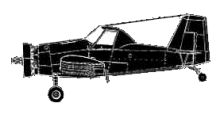
ASN Wikibase Occurrence # 131896
This information is added by users of ASN. Neither ASN nor the Flight Safety Foundation are responsible for the completeness or correctness of this information.
If you feel this information is incomplete or incorrect, you can submit corrected information.
| Date: | Wednesday 2 February 2000 |
| Time: | 15:00 |
| Type: |  Air Tractor AT-301 |
| Owner/operator: | Val Air Co. Inc. |
| Registration: | N23043 |
| MSN: | 301-0352 |
| Total airframe hrs: | 5693 hours |
| Engine model: | P&W AN1-R-1340 |
| Fatalities: | Fatalities: 0 / Occupants: 1 |
| Aircraft damage: | Destroyed |
| Category: | Accident |
| Location: | Brawley, CA -
 United States of America United States of America
|
| Phase: | Manoeuvring (airshow, firefighting, ag.ops.) |
| Nature: | Agricultural |
| Departure airport: | |
| Investigating agency: | NTSB |
| Confidence Rating: |
The pilot was spraying sulfur on a carrot field when he lost engine power and made a forced landing in an alfalfa field, coming to rest inverted. The pilot had noted an increase in oil consumption the day of the accident. A witness observed two puffs of black smoke emanate from the airplane prior to making the forced landing. During the engine inspection it was noted that the number 5 exhaust rocker arm was found broken. Further disassembly of the number 5 cylinder revealed that the exhaust push rod was bent; due to the appearance and length it was determined that it was the intake push rod. When the exhaust push rod and the intake push rod were placed side-by-side, the intake push rod was the longer of the two and the one that was bent. Maintenance personnel stated that the only way an intake push rod could be installed in the exhaust side of the cylinder was to loosen the cylinder and pull it away from the case to allow for an increased distance between the rocker arm and lifter. When the cylinder was re-torqued, with the push rods in a switched configuration, the intake push rod would bend in the exhaust housing due to its length. After replacement of the pushrods and broken rocker arm, an engine run was conducted with no anomalies noted. Review of the engine logbook revealed that a major overhaul had been conducted on the engine approximately 3 months prior to the accident. Records indicated a mechanic and inspector conducted an inspection of the cylinders and associated components; the engine was test run with no discrepancies and then inspected by a different mechanic and inspector and signed off by all four individuals as being in airworthy condition and returned to service. A review of the engine logbooks also revealed that maintenance had been performed on the airplane since the overhaul, but not in the area of the number 5 cylinder.
Probable Cause: Failure of the engine due to improper installation of the intake and exhaust push rods (components were switched) by unknown maintenance personnel.
Accident investigation:
 |
|
Sources:
NTSB: https://www.ntsb.gov/_layouts/ntsb.aviation/brief.aspx?ev_id=20001212X20510&key=1
Revision history:
| Date/time | Contributor | Updates |
|---|---|---|
| 21-Dec-2016 19:25 | ASN Update Bot | Updated [Time, Damage, Category, Investigating agency] |
| 12-Dec-2017 18:26 | ASN Update Bot | Updated [Source, Narrative] |
Corrections or additions? ... Edit this accident description
The Aviation Safety Network is an exclusive service provided by:


 ©2024 Flight Safety Foundation
©2024 Flight Safety Foundation